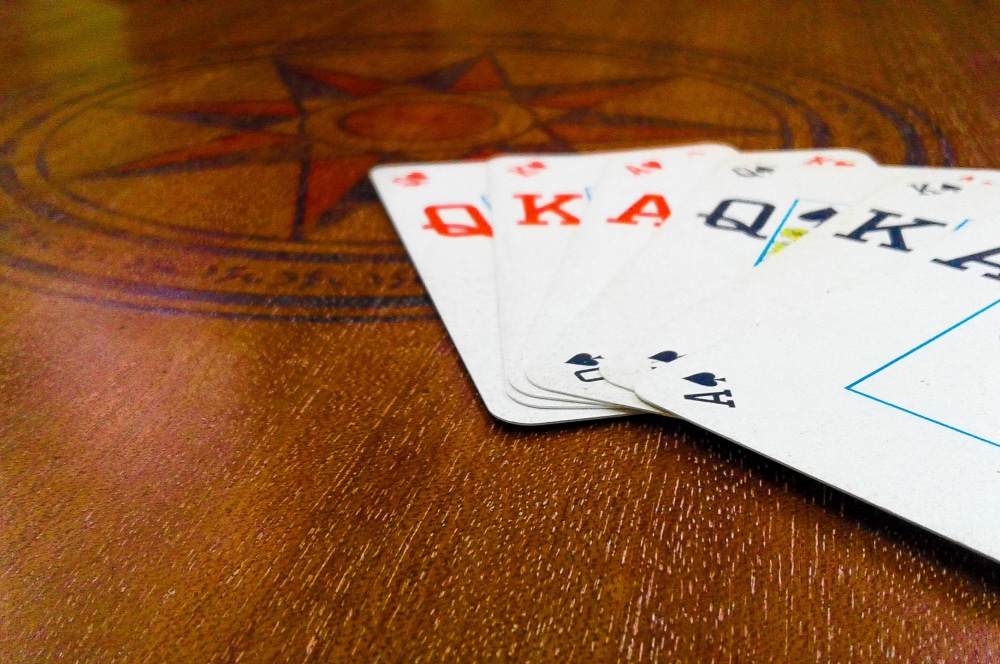The Canasta card game is fun but rarely played team game which originated in the 1950s in the US. Canasta is a bit complex for casual play, and it has some rules which make it difficult to learn for new players, but players familiar with Rummy will probably have the easiest time learning Canasta.
At its best, Canasta is immensely fun and has great strategic and tactical depth. Canasta is also a great way to socialize with people that you don’t know because it forces random teams with each new game, which can be helpful for introverts.
If you’ve ever wondered how to play Canasta, this is the article for you.
Who Is Canasta For?
Canasta is a competitive team game for players that are already familiar with Rummy or similar meld-making card games. Children will be in over their heads during a game of Canasta, as will many tweens and even some teenagers.
Canasta’s speed of play can vary, but in general, it maintains a moderate speed of play that can accelerate or slow down depending on the speed and skill of the players. Canasta is a game of skill rather than luck, though the draw can still cause frustration for the most tactical of players.
What Do I Need To Play Canasta?
To play Canasta, you’ll need:
- Two standard decks of cards including the Jokers
- Four players
- A notebook to keep score
- A square table
- Familiarity with Rummy or similar card games
What Are The Rules Of Canasta?
Canasta rules are complex and need to be closely followed. The objective of Canasta cards is to form the most melds of the highest value—in other words, the objective of canasta is to form the most valuable combinations of three or more cards that have the same rank.
The first step in any Canasta game is to form teams based on the card draw.
Take two decks of cards, Jokers included, and shuffle them together. Each player draws one card from the top of the stack then everyone puts their card face up. The players with the two highest cards are on the same team, just as the players with the two lowest cards are on the same team.
If by some crazy coincidence there is any ambiguity in this team forming method, just repeat the process. You can also use the ranking of suits to determine which card is higher, but since Canasta requires two decks of cards to play, it’s still possible for ties to occur.
After Team Making
Once the teams of two settle, it’s time to reorient. Players of the same team should sit opposite each other. Each player must now draw a single card again; the player who draws the highest card plays first.
Additionally, the player to the right of the player who draws the highest card is the player that becomes the dealer. The dealer then shuffles all of the cards, cuts the cards, and provides 11 cards to each player, face down.
Throughout gameplay, the person who deals shifts to the right by one player after each hand.
To start a turn, the dealer turns the top card of the remaining stock of cards face up and lays it next to the stock, creating the discard pile. If the card that joins the discard pile is a red three or a Joker, the dealer simply burns another card to the discard pile.
Play starts with the player sitting to the left of the dealer; this player draws a card from the top of the stockpile, or they can pick up the entire discard pile. Remember that picking up the entire discard pile can be advantageous if it contains cards that your team needs to make high-point melds.
Each player’s turn has two options. The player can choose to play a meld of three or more cards of the same rank, or do nothing. At the end of the turn, the player discards a card. The hand ends when a player plays a meld, leaving only one card in their hand, which is then discarded at the end of their turn.
At this point, the player has gone out. Once a player has gone out, the round ends and points tally.
There are several rules which govern making melds in Canasta that make things more complicated than they seem, however.
Making Melds And Tallying Points
The point values of each card in each meld are as follows:
- Red 3s: 100 points
- Jokers: 50 points
- 2s and Aces: 20 points
- Kings, Queens, and Jacks: 10 points
- 10, 9, and 8: 10 points
- 7, 6, 5, and 4: 5 points
- Other 3s: 5 points
As we’ll see later, this isn’t a comprehensive scoring guide, just the starting point for tallying the value of melds.
To place any meld, your team has to be “open.” Teams become “open” only when they can play a single contiguous meld that’s worth greater than a fraction of the points required to win the game. So, if the players agree that 1500 points are needed to win the game, the lowest tally that a meld can have before the team is open would be 50.
Once the team is open, they may play lower value melds.
There’s a catch, though. Before going out and ending the round, one member of your team has to make a Canasta.
How Do I Win Canasta?
In Canasta, “a Canasta” is a meld of seven or more cards that allows a member of one of the teams to go out. You can build on previously played melds however you please, but there are consequences to your methodology of how you build on previously established melds.
Certain cards in Canasta are “natural” whereas others are wild cards. Wildcards are Jokers and 2s. If you keep your melds and Canastas clean—devoid of wild cards—they’re worth more points at the end of the round. How much more they’re worth depends on the exact variant that you’re playing but sometimes avoiding wildcards can increase the value of your meld by as many as 200 points.
The Discard Pile
The discard pile is also subject to some rules in Canasta. While taking the entire discard pile was mentioned earlier as an option that players can exercise, they can only do so once the discard pile is unfrozen.
At the start of each player’s turn, the discard pile is considered frozen, meaning that it can’t get drawn until it’s unfrozen. To unfreeze the discard pile, the player must play a meld with at least two non-wild cards that combine with the top card of the discard pile. Once this melds, it’s put into play, removing the top card of the discard pile and leaving it as part of the meld.
After the discard pile has been unfrozen, the option of picking up the discard pile is open. To freeze the discard pile and interfere with the other team’s chances of drawing it, players may choose to discard a wildcard at the end of their turn. In this case, the discard pile becomes unfrozen after a player has discarded a non-wild card.
Wrapping Up Canasta
To win Canasta, you have to both go out—end the round—and have the sum of your melds be greater than the sum of your opponents’. Going out, as mentioned earlier, is the process of playing all of the cards in the player’s hand as melds, then discarding the last card, which can’t be done until one of the players has made a Canasta.
Players can make a Canasta in the process of going out, but they don’t necessarily have to be open—to have played a starting meld with a certain value—before making a Canasta and simultaneously going out. This is called going out concealed, and it’s worth an extra 100 points, meaning that it leads to some very tricky maneuvers that skilled Canasta players will use.
If your team can make a Canasta and go out without having made an opening meld, you’ll have a substantial advantage because of the way that scores are tallied. To find your team’s final score, add:
- The value of every meld your team played using the meld values mentioned earlier
- 300 points per Canasta with a wildcard
- 500 points per “natural” Canasta
- 100 points for going out
- 200 points if you went out concealed
Once your team hits the agreed upon point maximum, the game is over, and you win. Canasta is a tricky game with a ton of different rules, but it’s deeply rewarding if you can stick by the arithmetic and play strategically.

